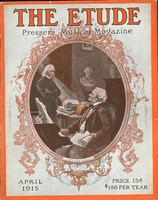PROFESSOR FREDERICK NIECKS has been writing in the London Monthly Musical Record on the subject of Adolf Henselt as man, pianist, composer and teacher. Speaking of Henselt’s touch, which Liszt said was “inimitable,” Niecks says: “Elasticity was at the bottom of this touch, and it was elasticity that was the aim of the efforts of increasing the extensibility of the hand. Henselt’s hands and fingers were short and fleshy. He must therefore have felt the necessity of widening his natural stretch more than other pianists, especially as a lover of Weber’s piano music. The extent to which he developed his small hands is astounding. He gives in a letter of his youth these two five-note combinations, and says:

‘While I hold the extension with one hand, I practice with the other. Besides this, I can also read or learn by heart.’ No wonder that his palms were quite flat and his hands like leather. It was by such drilling that the foundation was laid of Henselt’s always beautiful and always clear and brilliant touch. As the outstanding features of the master’s style of playing may be mentioned: the greatest possible purity and fullness of tone, absolute clearness whatever the speed or difficulty might be, and the most perfect legato and cantabile.
“In practicing Henselt used very largely a dumb piano, using it for conquering technical difficulties. His reason for doing so was that it spared the nerves. Miss Walker relates that his assistant lady-professors in St. Petersburg ‘invariably practiced on instruments for which they used two sets of sordines (two kinds of damping apparatus) : one which so deadened and softened the sound as to render it inaudible outside the room, while the second made the instrument a complete dummy.’ The master himself had in his study two grand pianos: one of them was muted and on it he practiced; the other was normal, and on it he played the pieces after he had mastered the technical difficulties. He seems to have discarded the dumb instrument in later years.
“Lenz tells us of Henselt’s evening study on a damped piano of Bach’s well-tempered clavier fugues, while at the same time he was reading in a Bible lying on the music desk before him, or keeping up a conversation with his friends. This seems to me one of Lenz’s dressed-up stories. Substitute technical exercises for Bach’s preludes and fugues, and you probably will be nearer the truth. All the accounts that have come down to us make it clear, and do not leave us in doubt as to the severity of his practicing. Indeed, Henselt’s practicing was so severe that it has been called slavish. But this fact must not mislead us into believing that he was a virtuoso of the finger hero type. All who heard him—the greatest pianists as well as others— admired his interpretations no less than his technique. Schumann, you remember, noticed in him something ‘daemonic,’ and said that Henselt had given him more pleasure than any other pianist he had heard. Four years later, in 1842, when Clara Schumann heard him again she found his playing as magnificent as before, indeed so magnificent as to discourage, and at the same time, incite her. Only she thought, rightly or wrongly, that, however distinct each tone, his touch had lost in delicacy by the great amount of his mechanical study, that it did not seem to her quite so ethereal, quite so poetic as formerly. To Hans von Bülow, in later years, the memory of Henselt’s playing was a never-to-be-forgotten enjoyment and a source from which he drew instruction and helpful stimulus. ‘One must have heard,’ Rubinstein writes, ‘Chopin, Liszt, Thalberg and Henselt, to know what genuine piano-playing means.”



